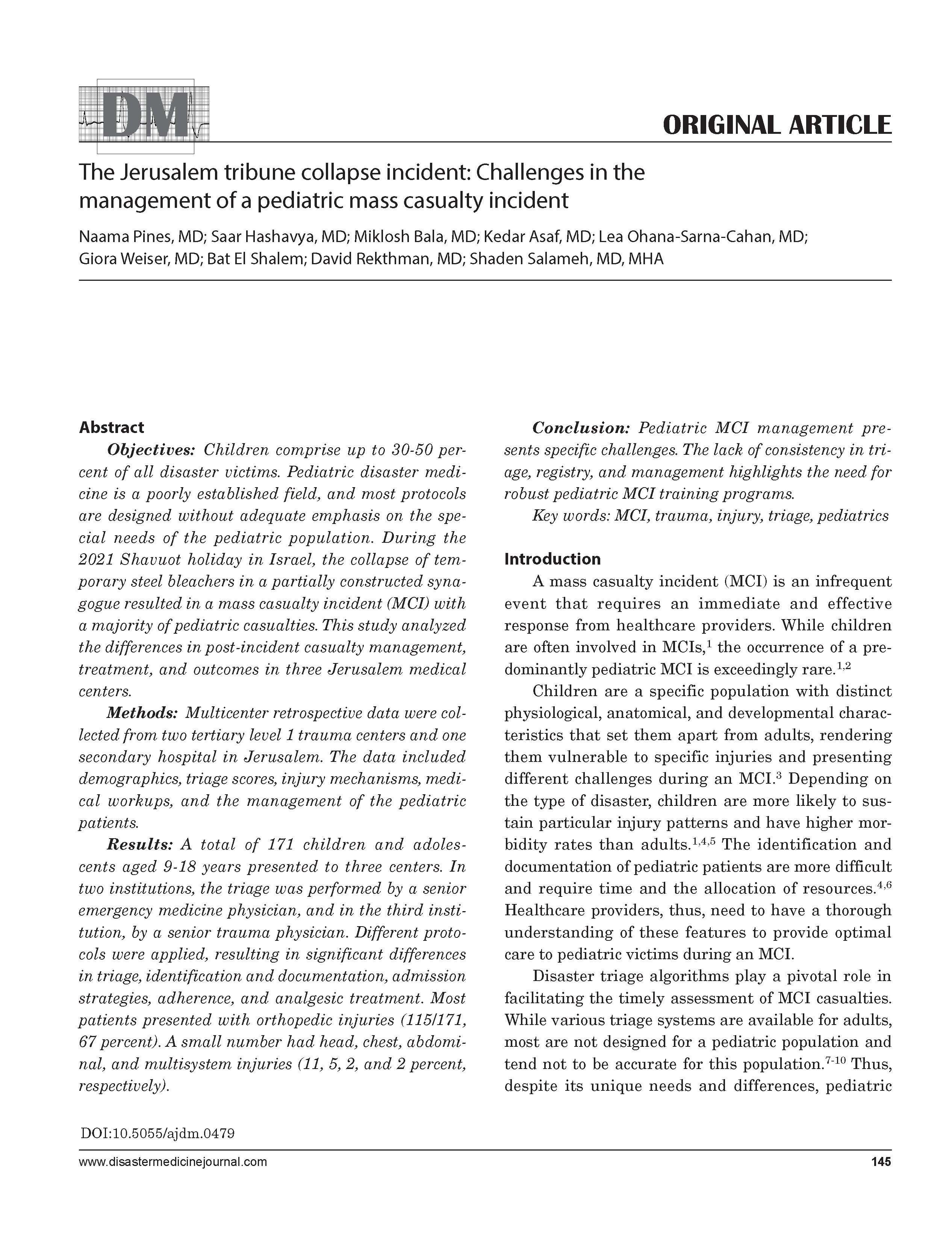The Jerusalem tribune collapse incident: Challenges in the management of a pediatric mass casualty incident
DOI:
https://doi.org/10.5055/ajdm.0479Keywords:
MCI, trauma, injury, triage, pediatricsAbstract
Objectives: Children comprise up to 30-50 percent of all disaster victims. Pediatric disaster medicine is a poorly established field, and most protocols are designed without adequate emphasis on the special needs of the pediatric population. During the 2021 Shavuot holiday in Israel, the collapse of temporary steel bleachers in a partially constructed synagogue resulted in a mass casualty incident (MCI) with a majority of pediatric casualties. This study analyzed the differences in post-incident casualty management, treatment, and outcomes in three Jerusalem medical centers.
Methods: Multicenter retrospective data were collected from two tertiary level 1 trauma centers and one secondary hospital in Jerusalem. The data included demographics, triage scores, injury mechanisms, medical workups, and the management of the pediatric patients.
Results: A total of 171 children and adolescents aged 9-18 years presented to three centers. In two institutions, the triage was performed by a senior emergency medicine physician, and in the third institution, by a senior trauma physician. Different protocols were applied, resulting in significant differences in triage, identification and documentation, admission strategies, adherence, and analgesic treatment. Most patients presented with orthopedic injuries (115/171, 67 percent). A small number had head, chest, abdominal, and multisystem injuries (11, 5, 2, and 2 percent, respectively).
Conclusion: Pediatric MCI management presents specific challenges. The lack of consistency in triage, registry, and management highlights the need for robust pediatric MCI training programs.
References
Costa VSLP, Stéfani GM, Ferenhof HA, et al.: Children’s health care in mass-casualty incidents: A systematic literature review. Prehosp Disaster Med. 2021; 36(6): 739-746.
Craigie RJ, Farrelly PJ, Santos R, et al.: Manchester Arena bombing: Lessons learnt from a mass casualty incident. BMJ Mil Health. 2020; 166(2): 72-75.
Burke RV, Iverson E, Goodhue CJ, et al.: Disaster and mass casualty events in the pediatric population. Semin Pediatr Surg. 2010; 19(4): 265-270.
Allen GM, Parrillo SJ, Will J, et al.: Principles of disaster planning for the pediatric population. Prehosp Disaster Med. 2007; 22(6): 537-540.
Grindlay J, Breeze KM: Planning for disasters involving children in Australia: A practical guide. J Paediatr Child Health. 2016; 52(2): 204-212.
Hohenhaus SMD: Practical considerations for providing pediatric care in a mass casualty incident. Nurs Clin North Am. 2005; 40(3): 523-533.
Heffernan RW, Lerner EB, McKee CH, et al.: Comparing the accuracy of mass casualty triage systems in a pediatric population. Prehosp Emerg Care. 2019; 23(3): 304-308.
El Tawil C, Bergeron A, Khalil E: A scoping review of pediatric mass-casualty incident triage algorithms. Disaster Med Public Health Prepared. 2023; 17: e317.
McGlynn N, Claudius I, Kaji AH, et al.: Tabletop application of SALT triage to 10, 100, and 1000 pediatric victims. Prehosp Disaster Med. 2020; 35(2): 165-169.
Donofrio JJ, Shaban A, Kaji AH, et al.: Comparison of outcome tools used to test mass-casualty algorithms in the pediatric population. Prehosp Disaster Med. 2021; 36(6): 719-723.
Burke RV, Kim TY, Bachman SL, et al.: Using mixed methods to assess pediatric disaster preparedness in the hospital setting. Prehosp Disaster Med. 2014; 29(6): 569-575.
Aharonson-Daniel L, Waisman Y, Dannon YL, et al.: Epidemiology of terror-related versus non-terror-related traumatic injury in children. Pediatrics. 2003; 112(4): e280-e280.
January S: Elsevier has created a COVID-19 resource centre with free information in English and Mandarin on the novel coronavirus COVID-19. The COVID-19 resource centre is hosted on Elsevier Connect, the company’s public news and information. 2020; 1: 19-21.
Kennedy K, Aghababian RV, Gans L, et al.: Triage: Techniques and applications in decision-making. Ann Emerg Med. 1996; 28(2): 136-144.
Christian MD: Triage. Crit Care Clin. 2019; 35(4): 575-589.
Claudius I, Behar S, Ballow S, et al.: Disaster drill exercise documentation and management: Are we drilling to standard? J Emerg Nurs. 2008; 34(6): 504-508.
Claudius I, Kaji AH, Santillanes G, et al.: Accuracy, efficiency, and inappropriate actions using JumpSTART triage in MCI simulations. Prehosp Disaster Med. 2015; 30(5): 457-460.
Delaney JS, Drummond R: Mass casualties and triage at a sporting event. Br J Sports Med. 2002; 36(2): 85-88.
Haft JW, Atluri P, Ailawadi G, et al.: Adult cardiac surgery during the COVID-19 pandemic: A tiered patient triage guidance statement. Ann Thorac Surg. 2020; 110(2): 697-700.
Maitland L, Middleton L, Veen H, et al.: Analysis of 983 civilian blast and ballistic casualties and the generation of a template of injury burden: An observational study. eClinicalMedicine. 2022; 54: 101676.

Published
How to Cite
Issue
Section
License
Copyright 2007-2025, Weston Medical Publishing, LLC and American Journal of Disaster Medicine. All Rights Reserved.

